Star chef Martin Benn’s blackened piri-piri chicken is your new dinner party go-to
The former Sepia chef shares his all-killer menu of sansho and sesame prawn toasts, blackened piri-piri chicken and barbecued 𝄒nduja eggplants, with a final flourish of decadent pink peppercorn chocolate fudge.
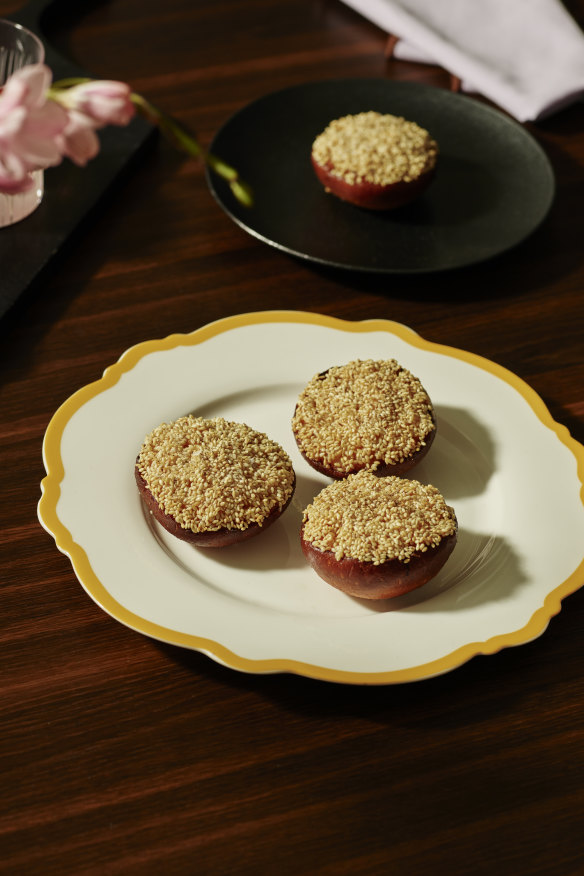
Prawn toasts, sansho and sesame
With fond memories from my time living in Hong Kong, I bequeath to you this fun twist on the dim sum classic that everyone loves. Prawn toast is the perfect appetiser because it goes so well with champagne or a cocktail, and it’s satisfying without being too rich.
INGREDIENTS
Prawn mix (makes 210g)
- 500g (about 6) whole king prawns, U6 size
- 1 tsp sansho pepper or Sichuan pepper, ground
- 1 tbsp shellfish oil
- 1 tsp salt
Toasts
- 3 x mini milk buns, or brioche-style mini burger buns
- 40g white sesame seeds (not toasted)
To cook and serve
- 1.5 litres vegetable oil
- salt and sansho pepper, for sprinkling
METHOD
- To make the prawn mix, peel the prawns (freeze the shells for future shellfish oils or stocks). Remove the intestinal tract from the prawns and discard. Arrange the prawns on a tray lined with paper towel and cover with more paper towel. Leave for 1 hour to absorb excess moisture. Chop the prawns into a coarse paste, and season with sansho pepper, shellfish oil and salt. Mix well together to make a sticky paste, then refrigerate in an airtight container until required.
- To assemble the toasts, cut the milk buns in half. Divide the prawn mix evenly among the 6 halves, then use a palette knife or spatula to spread it evenly over each cut side.
- Pour the sesame seeds into a shallow bowl and dip the prawn coating into the sesame seeds. Place on a tray and refrigerate until required.
- To cook, heat the oven to 50C fan-forced (70C conventional). Line a tray with paper towel and set aside. Heat the oil in a large, heavy-based pot until the temperature reaches 195C, then turn the heat to low.
- Working with two at a time, gently put the prawn breads in the oil, prawn-side up, and fry for about 1 minute. Flip over and fry for a further minute, or until the sesame seeds are golden. Lift out with a wire strainer or slotted spoon and place prawn-side down on the lined tray to remove excess oil, then flip over and season with salt and sansho pepper. Keep warm in the oven while you fry the remaining prawn toasts. Place on a serving plate and serve immediately.
Serves 6
Chef’s tip:
- You can use different species of prawns, such as banana, tiger or king, and indeed, different sizes. Bear in mind that once peeled and cleaned, the prawn meat will be roughly 40 per cent of the total weight.
- I prefer to buy green (raw) prawns frozen, and defrost as needed, to control freshness and reduce waste. Most prawns in the shops have been frozen and thawed anyway.
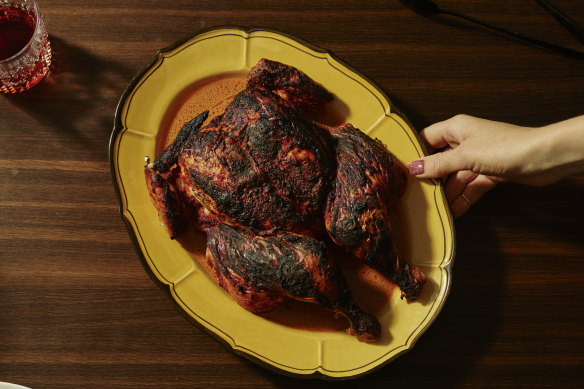
Blackened piri-piri chicken
If you haven’t brined chicken before, you are in for an epiphany. Brining makes the flesh so juicy and full of flavour – just make sure you have room in the refrigerator first! This is adapted from the famously spicy, charcoal-grilled piri-piri chicken of Portugal, one of the world’s great chicken dishes. The skin, coated with paprika and chilli paste, is dramatically blackened, but the chicken doesn’t dry out. Served with a sauce made from the lemony roasting juices, this is a great dish to share with friends.
INGREDIENTS
- 1.8kg whole free-range chicken
- 1 batch Best-ever brine (see recipe)
- 1 tbsp smoked hot paprika
- 100g Korean-style chilli paste or gochujang
To cook the chicken
- 2 lemons, cut into quarters
- sea salt and pepper
- 40ml olive oil
To serve
- 100ml chicken and lemon roasting juices
- 1 tbsp extra-virgin olive oil
- 1 tbsp red-wine vinegar, eg Forvm cabernet sauvignon
METHOD
- To brine the chicken, rinse the chicken under cold water, then pat dry with paper towel. Using a paring knife, remove the wishbone by scraping along each side of it. Use your fingers to find the top of the bone, then pinch and twist to pull it out. Place the chicken on a cutting board breast-side down, cavity hole facing you. Using heavy-duty scissors or poultry shears, cut either side of the backbone all the way through to the tail. Once cut through on both sides, remove the backbone and discard. Turn the chicken over and, using both hands, press down gently but firmly to flatten.
- Add the Best-ever brine to a large enough container to hold both brine and chicken. Submerge the chicken completely in the brine, cover with a lid and refrigerate for 12-16 hours.
- Drain well, discarding the brine, then pat the chicken dry with paper towel. Place the chicken on a wire rack set on a tray. Using a small sieve, dust the skin of the chicken with paprika. Refrigerate for an hour to let the paprika dry on the skin. Brush the chicken all over, including the underside, with the chilli paste, then refrigerate for 3-4 hours.
- To cook the chicken, put the lemon quarters into a bowl and season well with salt and pepper. Add the olive oil, tossing to coat. Put the lemon wedges in a heavy roasting dish, spread out to cover the centre of the dish, then add 200ml water. Place the chicken on top of the lemons, breast-side up and leave to sit at room temperature for 45 minutes before roasting.
- Heat the oven to 220C fan-forced (240C conventional). When hot, roast the chicken for 45 minutes, turning the dish around halfway through to ensure an even colouring of the skin. Allow the chicken to rest for at least 40 minutes in a warm place. Strain the roasting juices and lemons through a sieve into a clean small pan and set aside.
- To serve, warm the roasting juices in a small saucepan, and whisk in the olive oil and vinegar until emulsified. Season if required and keep warm. Serve the chicken either whole, or cut into pieces. To joint the chicken, first remove the wing tips and the wings. Remove both legs, then cut each leg in half at the thigh-bone joint, giving you two drumsticks and two thighs. Place the wings, drumsticks and thighs on a warm serving dish. Remove both breasts by cutting down the breastbone. Cut each breast into 6 even slices and place on the serving dish. Pour over the lemon sauce and serve immediately. Alternatively, pour the sauce onto the base of a serving plate, place the whole chicken on top, and carve at the table.
Serves 6
Chef’s tip:
- Ask your butcher to butterfly the chicken if you are not comfortable doing this yourself.
- Discard the brine after use, as it contains live bacteria.
Best-ever brine
It’s time to brine! This little chef’s secret is out: a well-brined piece of meat will rock your world. If you have not brined chicken for a roast dinner yet, you haven’t lived. Soaking the meat in salted water, which is essentially what brining is, will keep it incredibly moist, as well as imparting more flavour and seasoning, without it actually tasting salty. You can make this recipe your own by adding different flavours, so long as you don’t change the salinity of the brine or the length of brining time. The proportion of salt should be between 4-8 per cent of the water volume. Be sure to discard the brine after use, as it’s unsafe to use it again.
INGREDIENTS
- 4 litres water
- 300g table salt (7.5% of the water volume)
- 100g soft brown sugar (2.5%)
- 60ml dark soy sauce (1.5%)
- 100ml mirin (2.5%)
- 1 tbsp black peppercorns
- 1 tsp fennel seeds
- zest of 1 lemon
- 3 bay leaves
- 30g thyme, whole sprigs
- 2 garlic cloves
METHOD
- Pour 1 litre of water into a heavy-based pot and bring to the boil. Add all ingredients. Bring back to the boil and simmer for 1-2 minutes, until the salts and sugars have dissolved and the spices and aromatics are fragrant. Turn off the heat, then add the remaining 3 litres of water. Leave to cool. Once cold, pour into a container large enough to hold the liquid as well as the chicken – about 6-7 litres. Refrigerate, and allow the brine to cool to 5C. You’re ready to go forth and brine.
Makes 4.3 litres
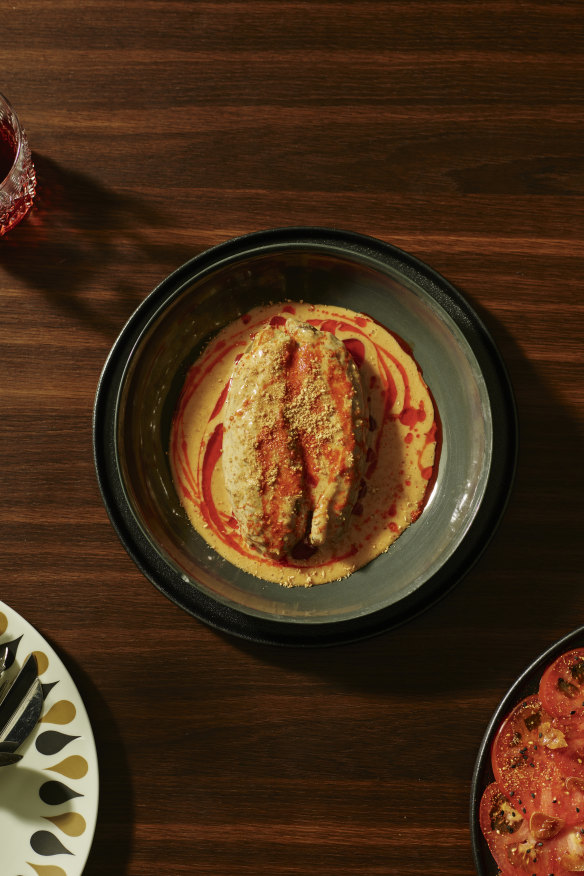
Barbecued eggplants, 𝄒nduja sesame
Eggplant is one of those vegetables that absorbs big, bold flavours like a sponge – and 𝄒nduja, that soft, spreadable, chilli-hot Calabrian salami, is a big, bold flavour. Use the barbecue to really char and blacken the outside of the skin. This will not only make the skin easier to remove but will also give the flesh a beautiful smoky flavour. A great side dish, this is nutty, buttery, smoky and spicy all in one.
INGREDIENTS
- 4 x 250g firm eggplants
Sesame seed salt
- 20g white sesame seed
- ½ tsp sea salt flakes
𝄒Nduja and sesame sauce
- 100ml seasoned rice wine vinegar
- 2 eschalots (French shallots) (60g), peeled and thinly sliced
- 200ml chicken stock
- 100g butter, diced and chilled
- 25g 𝄒nduja salami
- 35g sesame paste (tahini or goma)
Paprika oil
- 2 tbsp extra virgin olive oil
- 1 tbsp sweet smoked paprika
METHOD
- To prepare the sesame seed salt, toast the sesame seeds in a frying pan over a low-medium heat for 3-4 minutes, swirling the pan so that the seeds don’t scorch or burn. When toasty and fragrant, remove from the heat, pour onto a tray and allow to cool. Crush the salt flakes and sesame seeds in a mortar and pestle until they resemble coarse crumbs, then store them in an airtight container.
- To grill the eggplant, turn the barbecue to high and close the lid, letting the internal temperature reach 300C. Lightly prick the eggplants with a small skewer so they do not explode while cooking. When the barbecue is hot, chargrill the eggplants on all sides, making sure each part is blackened before you turn it. The eggplants will start to deflate and collapse on themselves. At this point, remove them from the barbecue, put them in a bowl, cover with cling film, and leave to cool completely.
- Once cool, remove all the charred skin and discard. Cut each eggplant in half lengthways and remove any excess seeds from the centre. Line a tray with a few layers of paper towel, then place the eggplants cut-side down on the tray to drain for as long as possible – overnight if possible. Cover and refrigerate for a few hours.
- To make the ’nduja and sesame sauce, add the seasoned rice-wine vinegar and shallots to a heavy-based saucepan. Bring to a simmer and reduce until almost all the vinegar has evaporated. Add the chicken stock and reduce again, until the liquid is half the original volume. Turn the heat to low, then slowly whisk in the butter, a few cubes at a time, until incorporated. Continue whisking constantly, and do not let the sauce boil. Once the butter is incorporated, remove from the heat and strain the sauce through a fine sieve into a clean small saucepan. Break the 𝄒nduja into small pieces and add it to the butter sauce along with the sesame paste. Using a hand-held blender, blitz the sauce until smooth and emulsified, then set aside.
- To make the paprika oil, combine the olive oil and paprika in a small bowl. Set aside.
- To serve, heat the oven to 160C fan-forced (180C conventional). Put the eggplants in a heatproof dish and place in the oven for 6-7 minutes to heat through. Meanwhile, return the 𝄒nduja and sesame sauce to the stove and warm to about 65C, whisking constantly. Arrange the warm eggplant on a high-rimmed serving plate. Blitz the sauce again using a hand-held blender, then add half the paprika oil. Spoon the sauce over the eggplants and drizzle with the remaining paprika oil. Scatter with the sesame seed salt, and serve immediately.
Serves 6
Chef’s tip:
- If you find 𝄒nduja too spicy, keep an eye out for sobrasada, a gently spiced, paprika-tainted cured pork sausage from the Balearic Islands.
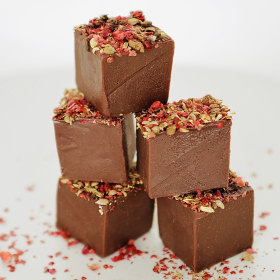
Pink peppercorn chocolate fudge
INGREDIENTS
Pink peppercorn spice mix
- 3 tbsp pink peppercorns
- 1 tsp Indian coriander seeds
- 1 tsp coriander seeds
- 1 tsp fennel seeds
- ⅛ tsp green cardamon seeds
- 1 tsp Aleppo chilli flakes
Chocolate fudge
- 396g tin condensed milk
- 1 tsp sea salt
- 250g chocolate
- 50g butter
METHOD
- To make the spice mix, toast the pink peppercorns in a heavy-based skillet until fragrant then remove and set aside. Combine the remaining spices and toast until fragrant. Set aside. Next, crush the pink peppercorns using a pestle and mortar and then pass through a sieve so that the pink flakes fall away. Reserve the pink flakes and discard the bitter centre of the peppercorn. Next, crush the remaining spices to a coarse texture using a pestle and mortar. Combine the pink peppercorn flakes with the crushed spices and set aside.
- To make the fudge, prepare a loaf tin (roughly 21cm x 11cm) by first lightly spraying with baker’s spray. Cut a sheet of greaseproof paper to the same size as the base of the tin and the longer sides and line the tin. This will help to remove the fudge from the tin once it has set.
- Pour the condensed milk into a heavy-based pan and heat gently over a low heat until it begins to bubble. Stir continuously so that the sugar in the condensed milk does not scorch. Add the salt and chocolate and remove from the heat. Stir until all the chocolate has melted and the mixture becomes smooth. If the chocolate does not melt completely, return to the heat and stir until smooth. Add the butter and continue to mix until smooth and silky. Pour the mixture into the lined loaf tin and smooth the surface. Place a sheet of greaseproof paper on top and allow it to cool at room temperature for at least 6 hours.
- Once set, remove the fudge from the tin by using a small knife to loosen the sides and then pull on the greaseproof paper. Place on a board, remove the greaseproof paper and then cut into 2cm squares. Place onto a tray lined with greaseproof paper, cover and set aside.
- To serve, dip one side of a fudge square into the pink peppercorn spice mix and place onto a serving plate. Repeat with the remaining squares. Sprinkle with more of the spice mix and season with sea salt before serving in the centre of the table.
Serves 6
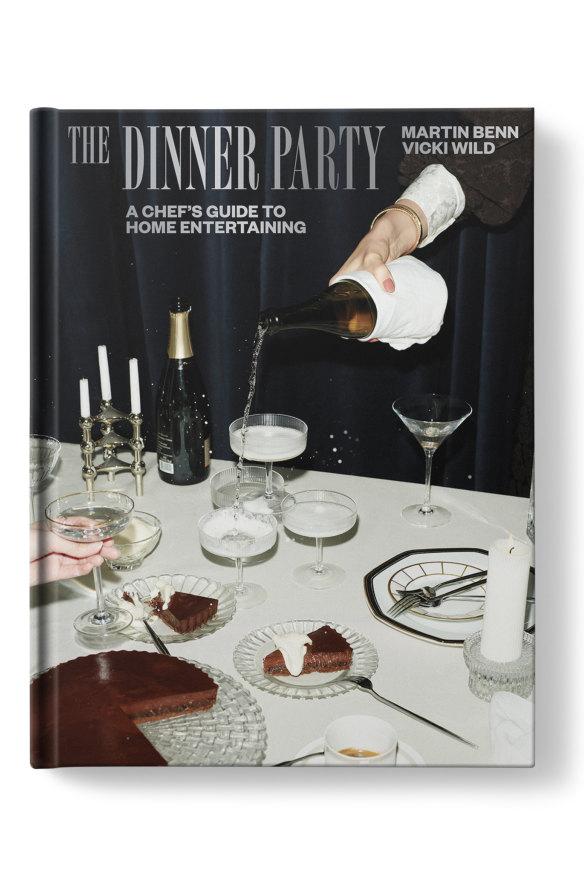
This is an edited extract from The Dinner Party by Martin Benn & Vicky Wild, Hardie Grant Books, RRP $60. Photography: Kristoffer Paulsen. Buy now
Appears in these collections
The best recipes from Australia's leading chefs straight to your inbox.
Sign up